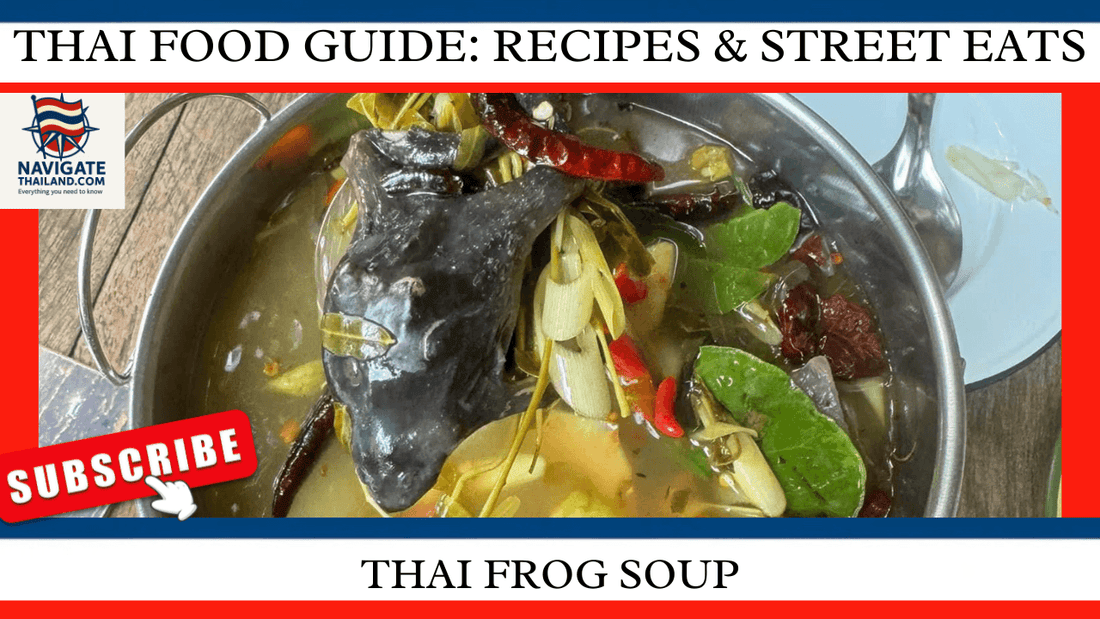
Thai Frog Soup: Tom Kha Kob
Share
Thailand’s culinary scene is renowned for its bold flavours, exotic ingredients, and rich history. From the fiery curries to the fragrant noodles, the cuisine is a reflection of the country’s cultural diversity. But beyond the familiar dishes lies a world of lesser-known delicacies that are deeply rooted in local traditions. One such dish is Isaan Frog Soup, a speciality from the northeastern region of Thailand, known as Isaan.
For travellers intrigued by unique and traditional dishes, Isaan Frog Soup is a must-try. This dish is more than just a meal—it’s a window into the rich cultural fabric of Thailand’s rural heartland. In this blog, we will dive deep into the history, ingredients, and cultural significance of Isaan Frog Soup, explore how and where the frogs are caught, how the dish is prepared, and whether there’s any connection to the French influence in Thailand.
The Frogs Used in Isaan Frog Soup
The main ingredient in Isaan Frog Soup is, unsurprisingly, frogs—specifically, the Asian bullfrog (Hoplobatrachus rugulosus), which is native to Southeast Asia. These frogs are commonly found in rice paddies, ponds, and wetlands throughout the region, and they play a significant role in local diets, particularly in rural areas like Isaan. While the idea of eating frogs might seem unusual to some, it is a common practice in this part of Thailand and many other cultures around the world.
Size and Appearance: The Asian bullfrog is relatively large compared to other frogs, with a bulky, muscular body. This makes it ideal for cooking, as it provides a decent amount of meat for a meal. The frogs used in the soup are usually around 8-12 centimetres in length.
Taste and Texture: Frog meat is often compared to chicken, with a mild flavour and tender, slightly chewy texture. Its delicate taste allows it to absorb the spices and herbs used in the soup, making it a perfect base for the strong flavours that define Isaan cuisine.
Fun Fact: In addition to frog soup, frogs are also commonly grilled, fried, or cooked in spicy salads in Thailand. They are considered a sustainable source of protein in many rural areas.
Where Do the Frogs Come From?
The frogs used in Isaan Frog Soup are typically wild-caught, though some frogs are also raised on small, local farms. Most of the frogs used in Isaan cuisine come from the wetlands and rice paddies that are abundant in northeastern Thailand. During the rainy season, when the rice fields are flooded, frogs thrive in the wet environment, making this time of year the ideal period for frog catching.
When They Are Caught: Frog hunting usually takes place in the rainy season, from May to October, when the wetlands are at their fullest. Local villagers, often farmers, venture out at night with flashlights and nets to catch frogs by hand or using simple traps. The nighttime expeditions are often a community activity, with families and friends gathering to catch frogs together. It’s also during this season that frog populations are highest, making it a sustainable practice as long as it’s done in moderation.
How They Are Caught: Traditionally, frogs are caught using nets or baskets, although some locals may use small traps placed near water sources where frogs are known to gather. Another method involves using lights to stun the frogs at night, which makes them easier to catch by hand. This practice has been passed down through generations and is still a common way to catch frogs in rural Thailand.
Fun Fact: Frog-catching is considered an important skill in rural communities, and for many villagers, it provides not only food but also an additional source of income, as frogs are sold at local markets.
How Isaan Frog Soup is Cooked
Isaan cuisine is known for its robust flavours, with heavy use of herbs, spices, and pungent ingredients like fermented fish sauce and galangal. Isaan Frog Soup is no exception. The dish is simple yet flavour-packed, typically cooked with a mix of local herbs and vegetables that enhance the natural flavour of the frog meat.
Ingredients in Isaan Frog Soup:
Frog Meat: The star ingredient, frog meat is chopped into bite-sized pieces. Both the meat and bones are used to add depth to the soup.
Fresh Herbs: Common herbs used include lemongrass, kaffir lime leaves, and galangal—all staples in Thai cuisine. These ingredients give the soup its signature fragrance and fresh, citrusy taste.
Chillies: Isaan cuisine is known for its spiciness, and frog soup is no different. Fresh or dried chillies are added to give the dish a fiery kick.
Fermented Fish Sauce: Known locally as pla ra, this is a pungent, fermented fish sauce that adds a savoury, umami depth to the soup. Pla ra is an essential ingredient in many Isaan dishes.
Vegetables: Often, local vegetables like bamboo shoots, morning glory, or cabbage are added to the soup to provide texture and additional flavour.
Rice: The soup is typically served with sticky rice, another hallmark of Isaan cuisine, which helps balance the spiciness of the dish.
Cooking Method
The preparation of the soup is straightforward. The frog meat is cleaned, cut into pieces, and boiled in a broth made from water, fish sauce, and fermented fish. Fresh herbs like lemongrass and kaffir lime leaves are added to the broth, along with chillies and vegetables. The soup is simmered for about 20-30 minutes until the meat is tender and the broth is infused with all the flavours of the herbs and spices.
Once cooked, the soup is served hot with sticky rice on the side, making for a hearty and satisfying meal. In Isaan households, it’s common for the entire family to sit together and enjoy this dish, often accompanied by other local favourites like som tam (green papaya salad) and grilled chicken.
The History of Isaan Frog Soup
The tradition of eating frogs in Thailand, particularly in the Isaan region, dates back centuries. Frogs have long been a source of protein in this part of the world, especially for rural communities where meat was historically less accessible. The dish likely evolved out of necessity, as people in rural Thailand relied on the land and waterways for food.
Over time, frog soup became a staple in Isaan cuisine, with different villages and families developing their own variations of the recipe. While the dish remains largely unchanged from its original form, modern ingredients and cooking techniques have occasionally been incorporated, especially in urban areas where access to certain traditional ingredients might be limited.
Cultural Significance of Frogs in Thailand
In Thai culture, frogs are often associated with good fortune and rain. In many rural communities, frogs are seen as a sign of fertility and a good harvest, as their presence indicates the arrival of the rainy season, which is crucial for rice farming. Some local festivals even feature frog-related rituals, where villagers pray for rain and bountiful crops.
In Isaan, frogs are more than just a source of food—they represent the connection between the people and their environment. Frog soup is a reminder of the region’s agricultural heritage and the importance of working with nature to sustain communities.
Did French Cuisine Influence Isaan Frog Soup?
The French are famous for their frog dishes, particularly cuisses de grenouille (frog legs), which are often sautéed with garlic, butter, and parsley. This raises an interesting question: Did French cuisine influence Isaan Frog Soup?
Thailand was never colonised by a European power, but it did have interactions with the French during the colonial era. However, the tradition of eating frogs in Thailand, particularly in rural areas like Isaan, predates any French influence. The practice of consuming frogs is more closely tied to local traditions and the agricultural lifestyle of the region, rather than being an adaptation of European cuisine.
That said, there are some similarities between French frog dishes and Isaan Frog Soup in terms of the main ingredient and its delicate, tender texture. However, the flavour profiles of the two dishes are entirely different. While French frog dishes tend to be rich and buttery, Isaan Frog Soup is characterised by bold, spicy, and tangy flavours, reflecting the region’s culinary style.
Fun Fact: While French cuisine may not have influenced Isaan Frog Soup, the French did introduce several ingredients, such as coffee and certain vegetables, to Thai cuisine during the colonial era in Southeast Asia.
How Isaan Frog Soup Has Evolved
Like many traditional dishes, Isaan Frog Soup has evolved over time. While the basic recipe remains the same, modern influences and the availability of new ingredients have led to some variations of the dish.
In urban areas, for example, it’s not uncommon to find frog soup made with farmed frogs rather than wild-caught ones. Additionally, some chefs have begun experimenting with the dish, incorporating different herbs or cooking methods to create their own unique takes on this traditional meal.
In terms of presentation, you might find more elaborate versions of the soup in restaurants, where the dish is plated beautifully and served alongside other contemporary Thai dishes. However, at its core, Isaan Frog Soup remains a rustic and authentic dish that reflects the simplicity and resourcefulness of rural Thai cooking.
Where to Try Isaan Frog Soup
For travellers eager to try this unique dish, the best place to do so is in the Isaan region itself, particularly in cities like Khon Kaen, Udon Thani, or Nakhon Ratchasima. These cities offer a wide range of restaurants and street vendors that specialise in traditional Isaan cuisine, including frog soup.
However, if you’re in Bangkok or other major cities, you can still find Isaan Frog Soup at some local markets or restaurants that focus on regional dishes. Rod Fai Night Market and Chatuchak Market in Bangkok are great places to explore authentic Thai food, and you may come across frog dishes there.
Conclusion
Isaan Frog Soup is more than just a meal—it’s a reflection of the cultural and agricultural heritage of northeastern Thailand. For centuries, this dish has been a staple in rural communities, providing nourishment and bringing families together. Its bold flavours, fresh ingredients, and connection to the land make it a truly unique culinary experience.
For travellers looking to immerse themselves in Thai culture, trying Isaan Frog Soup is a must. Whether you’re enjoying it at a local market or in the heart of Isaan itself, this dish offers a taste of Thailand’s rich history and traditions.
Have you tried Isaan Frog Soup or any other unique Thai dishes? Let us know in the comments below! And don’t forget to share this blog on your social media. Stay tuned for more interesting content, and remember that our blogs are also turned into videos, so make sure to like and subscribe to our YouTube channel to keep updated on the latest posts!
References:
Bangkok Post – https://www.bangkokpost.com
National Geographic – https://www.nationalgeographic.com
Isaan Record – https://www.isaanrecord.com
Read more of our Thailand blog series:
Thai Food Guide:Traditional Recipes and Street Eats
Everything Travellers Need to know
Thailand travel ebooks and language guides
Thailand Travel Apparel & Souvenir Gifts
Subscribe to our YouTube channel Navigate Thailand to see our most popular Thailand travel blogs turned into videos:
Navigate Thailand YouTube channel
